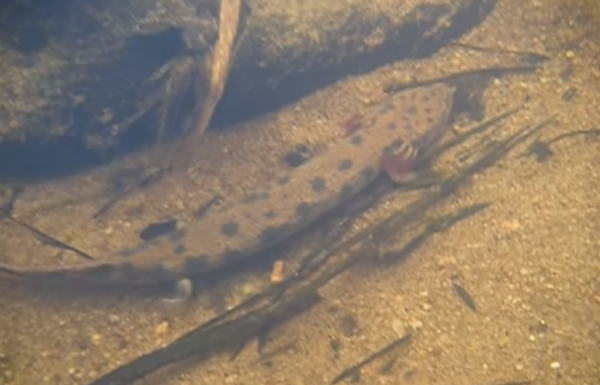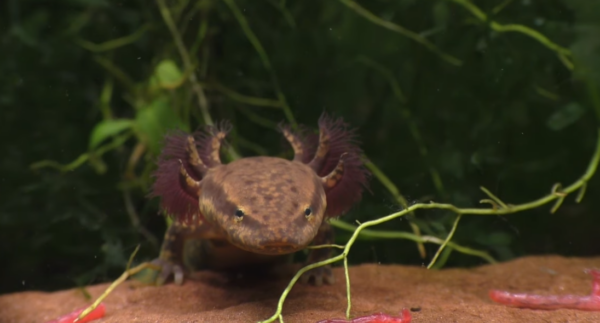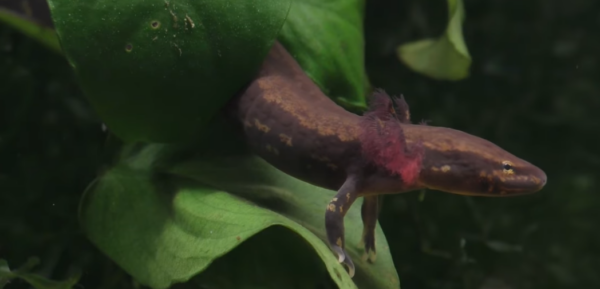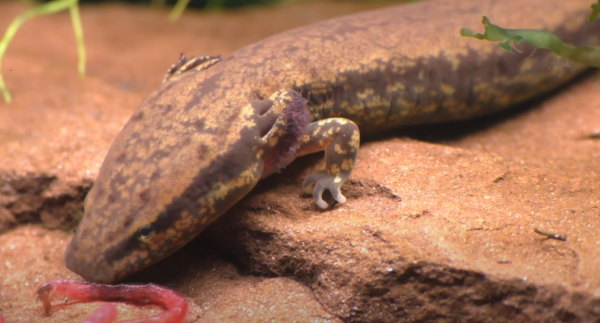Commonly referred to by their name Beyer’s Waterdog, the Water Dog Fish/Waterdog Fish are peaceful aquatic creatures who don’t go through the typical metamorphosis stage to transform into terrestrial adults. Unlike most salamanders, the Water Dog Fish retain their gills and streamlined bodies even in adulthood.
In this article, we’ll discuss every other thing about Water Dog Fish and help you give proper care to your favorite salamanders.
Table of Contents
Water Dog Fish Overview
Despite popular beliefs, Waterdog Fish spend their whole life in aquatic habitats without developing lungs or undergoing any transformation. Similar to other salamanders, however, they exhibit solitary behavior in the wild and have the ability to regenerate limbs.
| Information Chart | Water Dog Fish |
| Scientific Name: | Necturus beyeri |
| Family: | Proteidae |
| Care Level: | Intermediate |
| Temperament: | Solitary, partially social in small groups |
| Color: | Brown or gray with dark spots. |
| Lifespan: | 10 – 20 years |
| Size: | 6 to 9 inches |
| Diet: | Carnivorous diet. Small aquatic invertebrates, insects, and small fish. |
| Minimum Tank Size: | 20 gallons |
| Temperature: | 50 to 70F |
| WaterConditions: | pH: 6.5 to 7.5Soft water hardnessWell-oxygenated water |
| Tank Mate Compatibility | Best kept alone or with other Water Dog Fish in larger tanks. |
Water Dog Fish Appearance
The appearance of Waterdog fish is particularly suitable for aquatic environments. They have a small, streamlined body of 6 to 9 inches with a functional tail and slimy texture. Waterdog Fish generally have a brown or gray body with darker spots to blend into their natural environment.

The most notable feature of Waterdog Fish is their frilly, feathery external gills, located on either side of their head. They exchange gasses and respires through their gills and skin.
They also have well-developed legs, each ending in four toes; which allow them to move underwater and on the substrate. While two nostrils also are present in Waterdogs, they aren’t used for respiration but to detect chemical cues in the water.
Types/Varieties of Water Dog Fish
Except for coloration and size variations, type differences are non-existent in Waterdog Fish.
However, other salamanders, such as Tiger Salamander and Axolotl, are often confused with this species. While they all belong to the same family, they have unique character traits that make them different.
For example, the larvae stage of Tiger Salamanders go through metamorphosis and Axolotl is more vibrant. Waterdog Fish neither goes through metamorphosis nor has the vibrant colors of Axolotl.
Lifespan of Water Dog Fish
Waterdog Fish can live a long life if kept in a healthy environment. They often live between 10 to 20 years with proper care and nutrition. Things that influence the lifespan of Waterdog Fish include:
- Enforced metamorphosis
While not common, Waterdog Fish can be metamorphosed into a type of terrestrial salamander with thyroid injections and other abusive methods. This can significantly shorten their lifespan and may even cause premature death.
- Habitat and enclosure
Providing your Waterdog Fish with a proper habitat and enclosure can increase their lifespan by a significant margin. The habitat-related details are discussed later.
- Diet
A proper diet with a balance of every required nutrition is critical for a Waterdog Fish to thrive. While they’re capable of preying on live insects and worms, you should also consider commercial salamander food to fulfill additional nutrient requirements.
- Water quality
Waterdog Fish require well-oxygenated tanks and proper chemical balance to survive. Continuous monitoring, rapid actions, and water changes are fundamentals to maximize the lifespan of your Waterdog Fish.
- Social interactions
Waterdog Fish are solitary creatures. Even in the wild, they prefer to keep their activities to themselves and occasionally co-exist together in small groups. In smaller tanks, they often get stressed and anxious with the presence of other species or their own. This may make them susceptible to diseases and reduce their lifespan.
Water Dog Fish Size
Waterdog Fish are a small species of salamander. In captivity, with proper care, Waterdog Fish can grow even up to 9 inches. But, that requires proper tank maintenance, environmental conditions, and nutrition.
Natural Habitat and Origin
This salamander species is found in the Southeastern United States in the states of Mississippi, Louisiana, and Alabama. They typically inhabit freshwater habitats such as rivers, streams, and wetlands. Being adapted to an aquatic lifestyle, they aren’t found on the land.
Water Dog Fish Care & Tank Set-Up

Although Waterdog Fish aren’t a species of fish, you need to provide them with a proper aquatic environment, which includes a large enough tank, maintaining water parameters, and accompaniments.
Water Dog Fish Tank Size and Specifications
The optimum specifications for the Waterdog Fish tank are,
– Optimum Tank Size for Water Dog Fish
You don’t need a massive tank to house your Waterdog Fish. A 20-gallon tank is enough for two Waterdogs to wait for their food to arrive.
Typically, they remain pretty idle during the day and moderately active during the night. Their activities usually consist of searching/hunting for food, burrowing the substrate, and exploring the tank. Owing to them being sedentary, a larger tank is often deemed redundant for Waterdog FIsh.
– Tank Shape for Water Dog Fish
Regular rectangular tanks should suit your Waterdog Fish pretty well. However, as they’re not active swimmers, you may also go for any other shape that has enough space to move on the substrate.
Tip: As Waterdog Fish requires well-oxygenated water to thrive, choose something with more surface area over height.
Dimensions for a 20-gallon rectangular Waterdog Fish tank should be around 30″ x 12″ x 12″
– Filter Type
Waterdog Fish, being strictly carnivorous, produce a lot of waste. Mechanical and biological filtration systems are necessary to filter the water from organic particles and keep the nitrogen cycle going.
Depending on the size of your tank, an HOB filter with filter floss and bio-balls should be adequate. Proprietary filtration systems should also work fine.
For larger tanks with multiple Waterdog Fish, canister filters can be better alternatives.
However, Salamanders don’t appreciate high water flow. Anything over 100 GPH for a 20-gallon aquarium would be stressful for your Waterdog.
– Substrate
Being bottom dwellers, the choice of substrate is pretty critical for Waterdog Fish. While they can swim, adult Water Dogs prefer using their limbs to walk around the tank. Sandy substrates may be used for better grip and burrowing, or they can be left bare bottom.
– How many Water Dog Fish in a 20 gallon tank
An individual Waterdog Fish can be kept in a 20-gallon tank.
Water Parameters for Water Dog Fish
Waterdog Fish are pretty sensitive to temperature and chemical parameter changes. Here are the most fundamental water parameters that you need to monitor and optimize continuously.
– Water Temperature
Being cold-blooded creatures, the metabolism rate of Waterdog Fish slows down in colder temperatures and heightens in warmer waters. They prefer colder water temperatures where they can avoid being overheated.
As evident from the information chart, they thrive in the temperature range of 10 to 20 degrees C or 50 to 70 degrees F. They may get more inactive or active depending on the water temperature change.
Keeping the recent climate changes in mind, here are a few tips to reduce the water temperature in summer:
- Keep the tank in the shade and where it’s cooler in your house. Keep the curtains on till evening to avoid warming up the room.
- Use a fan over the tank to increase evaporation and reduce temperature.
- Use ice bags to reduce the temperature of the water.
- If it’s really hot and your Waterdog is being very active, do a water change with cooler water.
– Water Flow Rate
Waterdog Fish inhabits slow-moving rivers and streams. They also aren’t capable swimmers. Keeping a water flow rate of around 100 GPH is optimum for this species of salamander.
– pH Level
As long as it’s not very acidic, the pH levels don’t particularly matter to Waterdogs. Keeping it in a virtually neutral range of 6.5 to 7.5 should be optimum enough to sustain them. Here are a few tips to manage the pH levels in your Waterdog tanks:
- Use a digital pH meter to constantly monitor the levels.
- Commercial pH buffers stabilize the level pretty well.
- Driftwood, Indian Almond leaves, and many other plants can regulate pH levels in the tank.
- Major water changes can cause a pH spike in the tank, so be careful.
- RO water can reduce pH levels.
– Water Hardness
Use de-chlorinated tap water or RO water for Waterdog Fish. Keep the water hardness at a softer degree of 2-5 dGH.
Water Dog Fish Tank Landscape
The integral parts of tank landscaping for Waterdog Fish are discussed below:
– Best Plants for Water Dog Fish Tanks
The best aquatic plants for Waterdog Fish, which also are pretty good oxygen suppliers, include:
- Water Wisteria
- Hornwort
- Anubias
- Java Moss
- Cryptocoryne
- Echinodorus
- Vallisneria
- Water Lettuce
- Duckweed
- Anacharis
– Worst Plants for Water Dog Fish Tanks
Waterdog Fish prefers living in dim conditions with lots of vegetation and prey. However, not all aquatic plants are suitable for this species of salamander.
Some common aquatic plants, such as Ivy and Lilies can be poisonous to salamanders. It’s best to avoid them and focus on the suitable plants listed above.
Additionally, plants with hard leaves should be avoided to prevent damaging their delicate and sensitive mouthparts.
Fast-growing, weaker plants can overtake the tank and can be uprooted by your Waterdog Fish. It’s better to not experiment with the likes of them.
Plants that require fertilizers or hard light are best avoided. The fertilizers used on the plants can be absorbed by your Waterdog’s skin and harm them.
– Decorations for Water Dog Fish Tanks
You need to arrange for explorative places and hiding spaces for your Waterdog Fish. Here are a few decorative items that may help you with that:
- PVC pipes. Make sure to file their sharp edges away.
- Stone caves. Readymade caves should be available in the stores, but you also can DIY them.
- Driftwood.
– Lighting for Water Dog Fish Tanks
Being nocturnal, bright day or night light can stress them. Avoid bright lighting during the day and use lunar lighting at night to support the nocturnal activities of your Waterdog Fish.
Feeding Water Dog Fish
A strict carnivorous or meat-based diet is required for Waterdog Fish. Although they have rudimentary teeth, those are used for gripping rather than being used for chewing or biting. Therefore, they eat only what fits in their mouth.
Best Diet for Water Dog Fish
The best food for Waterdog Fish should strike the right balance between protein, fat, and vitamins. You can feed them live or frozen food as long as they can be swallowed whole. Some of them include:
- Blackworms
- Bloodworms
- Salamander Pellets or other carnivorous pellets
- Beef Heart and Salmon, shredded to fit into the Waterdog’s mouth
- Brine Shrimp
How often should you feed Water Dog Fish?
Feed adult Waterdogs 2 to 3 times a day. Feed them daily until they’re around a year old to support their growth and faster metabolism. Afterward, you may resort to feeding once every day.
Water Dog Fish Behaviour and Temperament
Waterdog Fish are interesting aquatic salamanders with a solitary and nocturnal lifestyle. They’re exceptional hiders who use rocks, debris, and vegetation for cover. They can be territorial and may not tolerate the presence of other salamanders or aquatic creatures in their proximity.
They’re generally pretty slow movers with low metabolism and external gills for respiration purposes. They also have weak visual perception that mostly helps with detecting movement and navigating their environment.
Water Dog Fish Tank Mates
As discussed, Waterdog Fish are solitary creatures and don’t appreciate the presence of other creatures in their territory. However, they sometimes can co-exist in small groups in the wild during breeding seasons.
If you must, keep 2 or 3 Waterdog Fish at most in larger tanks (more than 30 gallons) with adequate food and filtration so they don’t fight for resources.
Moreover, most tropical fish can’t tolerate the colder water temperatures suitable for salamanders.
Water Dog Fish Common Diseases and Their Treatment

Columnaris
Characterized by a cotton-ball-like growth, Columnaris infection is often found on the gill stalks of Waterdog Fish. The growths often appear as translucent white intertwined fibers. If left untreated, it can infect the whole internal system of Waterdogs.
The usual treatments involve maintaining clean water, providing nutritious food, and using Seachem Prime. Rapid infections can be treated with antibacterial medication like Furan 2.
Saprolegnia
In contrast to Columnaris, Saprolegnia is a fungal infection that attacks necrotic or damaged tissues of Waterdog Fish. It appears as a hairy and patchy infection; resembling dandelion fluff. It can lead to skin lesions, septicemia, and circulatory failures if left untreated.
The most common treatments for Saprolegnia involve clean water and proper nutrition. Adding tannins to the water and methylene blue baths may also be effective in later stages. Salt baths can be a last resort option for Saprolegnia.
Facts about Water Dog Fish
- Waterdog Fish have external gills. They lack developed lungs to live on the land.
- Waterdogs are part of an ancient salamander family.
- Waterdog Fish are primarily nocturnal and stay inactive during the day.
- They are ambush predators who wait for their prey to pass them.
- These salamanders are usually solitary and territorial, but they are occasionally seen in small groups in the wild.
- Water Dogs are cold-water species and they can’t tolerate very high temperatures like tropical fish species.
- They can live for up to 20 years in captivity with proper environmental and nutritional conditions.
- Their primary diet includes small aquatic invertebrates, but they also eat small fish, tadpoles, and insects.
- They are well adapted to their aquatic environment with a streamlined body and tail fin.
- In captivity, they should be kept alone or with other Waterdog Fish to avoid predation and stress.
- These salamanders have small, dark eyes. Implying limited visual perception.
- They have an efficient sense of smell to detect prey.
- Waterdogs often engage in cannibalistic behavior, especially towards smaller larvae.
Are Water Dog Fish Right For You?
Waterdog fish are only right for those aquarists who have some experience with salamanders and other amphibians. Due to the limited resources available on Waterdog Fish, experience is your only guide to properly care for these amphibians.
However, this guide should also help you get started with your new friend.
FAQ
Many varieties of salamanders, both aquatic and terrestrial, are called Water Dog Fish. We’ve covered the Waterdog Fish (Necturus beyeri) in this article.
The Waterdog Fish are called water dogs because they live in the water throughout their lives and are highly adapted to the environment.
Waterdog Fish are smaller species of salamanders who don’t usually grow beyond 9 inches.
The Bottom Line
We’ve delved into an in-depth discussion of Waterdog Fish or Water Dog Fish in this article. Hopefully, you’ll now be able to care for these aquatic salamanders and offer a suitable home to them.
No related posts.

